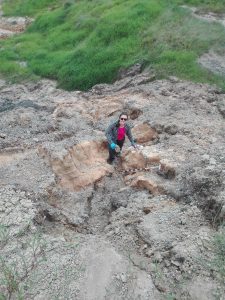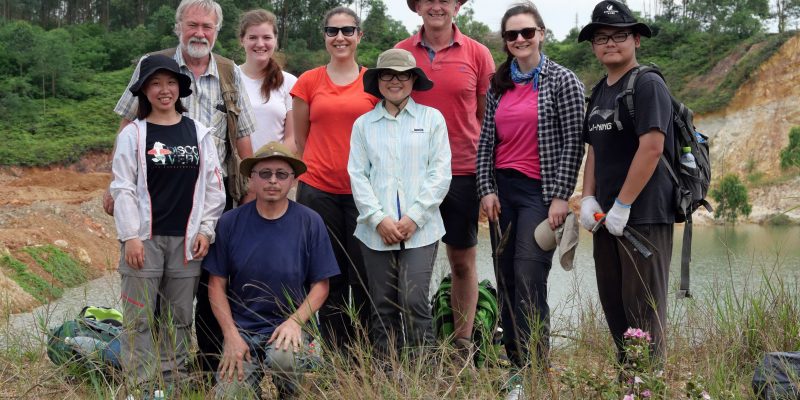The latest fieldwork for the UMBRELLA team brings us to south east China, in the regions of Guangdong and Hainan. Two new members are joining the team to continue exploring the potential of biomarker analysis in these sections: Caitlyn Witkowski and Vittoria Lauretano. We are also accompanied by Alexei Herman and Ksenia Domogatskaya, experts in paleobotany from the Laboratory of Paleofloristics at the Geological institute of the Russian academy of Science in Moscow.
Our trip starts in Guangzhou, with a visit to collaborators at Sun Yat-Sen University, Prof. Jianhua Jin and Xiaoyan Liu, who are experts in paleobotany of the area and give us an introduction on the state of their work and the possible locations we will be targeting during the first part of this fieldwork. Despite a long trip, we fight jetlag with a walk around the city and a boat trip along the Zhujiang or Pearl river, which gives us a lovely view of the city (although we do not recommend being gently rocked by the waves if you’re trying to stay awake!).

Long section near Maoming
Led by Xiaoyan Liu, the groups heads to Maoming, a large city in south Guangdong. From here, we explore the area and decide to focus on a long section exposed in an old clay pit. The alternation of reddish clay-rich to whitish layers and interbedded coal deposits offers promising potential for biomarker analyses as we expect good preservation and limited thermal degradation of organic matter! Good news for the biomarker team, who start collecting samples along the section, while unfortunately very little fossil leaves are uncovered, for the disappointment of the paleobotanists in the group!

Getting locals interested in paleobotany
We keep exploring the area and find an additional short section with beautifully preserved organic-rich layers and, for the joy of the paleobotanists, a rich paleo-leaf assemblage. As usual the presence of a bunch of geologists hammering rocks attracts the interest of the locals, who are curious about our findings and delighted by Bob’s detailed explanation, despite the significant Cantonese-Mandarin-English language barrier! Hand gestures and fossils work better than a 1000 words!
Next, we visit a location uncovered by the SYSU group with a perfectly preserved mummified wood. This offers the opportunity for the group to have a little adventure in the jungle-like vegetation surrounding the lake. A first attempt at penetrating the dense vegetation reveals to be a failure, with mosquito attacks and impossible-to-win bushes, despite our best efforts! The following morning, we brave the jungle again and… success! We reach the site and are able to sample part of the mummified wood log, not without relying on the woodwork skills of our PI, Prof. Paul Valdes. Mummified wood is a fossil of wood that has not been “permineralized” into rock and therefore its organic structure can still be analysed and can inform us about the climatic conditions the tree experienced throughout its lifetime up to its rapid burial. We hope that these samples will give us useful information about the climate at the time this tree lived!

Biomarker sampling calls for all hands on deck!
Time to leave Maoming and sail to Hainan Island. The hot temperature and high humidity don’t discourage the team and over the next 2 days we work on extending a long section close to Chang Chang, in the exposed portion of a submerged clay pit. We collect biomarker as well as palynological samples. Having information on both pollen assemblages and organic geochemistry proxies will help us identify the paleo environmental and climatic conditions at deposition, and pollen biostratigraphy will help in the geochronological framing of this section.
To escape the hot temperature, we decide to visit the Mangrove Nature Reserve, close to Haikou, a beautiful example of mangrove conservation in China that is helping preserve and study this unique ecosystem.
Our time in Hainan is over and heading back to Guangzhou reveals to be a long 13- hour trip! But we never fail a chance to enjoy our celebrity status, with people asking to take a photograph with us on the ferry back to the mainland!

Enjoying our celebrity status
